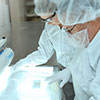Cloning+Kits+and+Ligation
Catalog Number:
(10423-970)
Supplier:
Bioss
Description:
Serine-threonine kinase which transduces inflammatory and cell-death signals (programmed necrosis) following death receptors ligation, activation of pathogen recognition receptors (PRRs), and DNA damage. Upon activation of TNFR1 by the TNF-alpha family cytokines, TRADD and TRAF2 are recruited to the receptor. Phosphorylates DAB2IP at 'Ser-728' in a TNF-alpha-dependent manner, and thereby activates the MAP3K5-JNK apoptotic cascade. Ubiquitination by TRAF2 via 'Lys-63'-link chains acts as a critical enhancer of communication with downstream signal transducers in the mitogen-activated protein kinase pathway and the NF-kappa-B pathway, which in turn mediate downstream events including the activation of genes encoding inflammatory molecules. Polyubiquitinated protein binds to IKBKG/NEMO, the regulatory subunit of the IKK complex, a critical event for NF-kappa-B activation. Interaction with other cellular RHIM-containing adapters initiates gene activation and cell death. RIPK1 and RIPK3 association, in particular, forms a necrosis-inducing complex.
Supplier:
Quantabio
Description:
sparQ PureMag Beads is a fast and reliable nucleic acid purification system for reaction cleanup and size selection in Next Generation Sequencing (NGS) workflows. Based on the reversible nucleic acid-binding properties of magnetic beads; this product can be used to quickly remove primers, primer-dimers, unincorporated nucleotides, salts, adapters and adapter-dimers from NGS library prep reactions to improve downstream sequencing performance. sparQ PureMag Beads allows excellent recovery of fragments greater than 100 bp without centrifugation or filtration. Consistent and reliable size selection can be achieved by simply adjusting the beads to sample ratio. This product is designed for both manual and automated processing, allowing seamless integration into existing workflows.
Catalog Number:
(76078-556)
Supplier:
Bioss
Description:
Serine-threonine kinase which transduces inflammatory and cell-death signals (programmed necrosis) following death receptors ligation, activation of pathogen recognition receptors (PRRs), and DNA damage. Upon activation of TNFR1 by the TNF-alpha family cytokines, TRADD and TRAF2 are recruited to the receptor. Phosphorylates DAB2IP at 'Ser-728' in a TNF-alpha-dependent manner, and thereby activates the MAP3K5-JNK apoptotic cascade. Ubiquitination by TRAF2 via 'Lys-63'-link chains acts as a critical enhancer of communication with downstream signal transducers in the mitogen-activated protein kinase pathway and the NF-kappa-B pathway, which in turn mediate downstream events including the activation of genes encoding inflammatory molecules. Polyubiquitinated protein binds to IKBKG/NEMO, the regulatory subunit of the IKK complex, a critical event for NF-kappa-B activation. Interaction with other cellular RHIM-containing adapters initiates gene activation and cell death. RIPK1 and RIPK3 association, in particular, forms a necrosis-inducing complex.
Catalog Number:
(10423-982)
Supplier:
Bioss
Description:
Serine-threonine kinase which transduces inflammatory and cell-death signals (programmed necrosis) following death receptors ligation, activation of pathogen recognition receptors (PRRs), and DNA damage. Upon activation of TNFR1 by the TNF-alpha family cytokines, TRADD and TRAF2 are recruited to the receptor. Phosphorylates DAB2IP at 'Ser-728' in a TNF-alpha-dependent manner, and thereby activates the MAP3K5-JNK apoptotic cascade. Ubiquitination by TRAF2 via 'Lys-63'-link chains acts as a critical enhancer of communication with downstream signal transducers in the mitogen-activated protein kinase pathway and the NF-kappa-B pathway, which in turn mediate downstream events including the activation of genes encoding inflammatory molecules. Polyubiquitinated protein binds to IKBKG/NEMO, the regulatory subunit of the IKK complex, a critical event for NF-kappa-B activation. Interaction with other cellular RHIM-containing adapters initiates gene activation and cell death. RIPK1 and RIPK3 association, in particular, forms a necrosis-inducing complex.
Catalog Number:
(10423-988)
Supplier:
Bioss
Description:
Serine-threonine kinase which transduces inflammatory and cell-death signals (programmed necrosis) following death receptors ligation, activation of pathogen recognition receptors (PRRs), and DNA damage. Upon activation of TNFR1 by the TNF-alpha family cytokines, TRADD and TRAF2 are recruited to the receptor. Phosphorylates DAB2IP at 'Ser-728' in a TNF-alpha-dependent manner, and thereby activates the MAP3K5-JNK apoptotic cascade. Ubiquitination by TRAF2 via 'Lys-63'-link chains acts as a critical enhancer of communication with downstream signal transducers in the mitogen-activated protein kinase pathway and the NF-kappa-B pathway, which in turn mediate downstream events including the activation of genes encoding inflammatory molecules. Polyubiquitinated protein binds to IKBKG/NEMO, the regulatory subunit of the IKK complex, a critical event for NF-kappa-B activation. Interaction with other cellular RHIM-containing adapters initiates gene activation and cell death. RIPK1 and RIPK3 association, in particular, forms a necrosis-inducing complex.
Catalog Number:
(75790-932)
Supplier:
Prosci
Description:
Ubiquitin-Like Protein ISG15 (ISG15) is a ubiquitin-like protein that becomes conjugated to many cellular proteins upon activation by interferon-alpha and -beta. Several functions have been ascribed to the encoded protein, including chemotactic activity towards neutrophils, direction of ligated target proteins to intermediate filaments, cell-to-cell signaling, and antiviral activity during viral infections. While conjugates of this protein have been found to be noncovalently attached to intermediate filaments, this protein is sometimes secreted. ISG15 becomes conjugated to a diverse set of proteins after IFN-alpha/beta stimulation or microbial challenge. The functions or biochemical consequences ISG15 conjugation to proteins are not yet known, but it appears that this modification does not target proteins for proteasomal degradation. ISG15 shows specific chemotactic activity towards neutrophils and activates them to induce release of eosinophil chemotactic factors. Upon interferon treatment, ISG15 can be detected in both free and conjugated forms, and is secreted from monocytes and lymphocytes where it can function as a cytokine. In the cell, ISG15 co-localizes with intermediate filaments and ISGylation may modulate the JAK-STAT pathway or certain aspects of neurological disease.
Supplier:
Lonza
Description:
SeaKem® is a high gel strength, low EEO, standard gelling temperature agarose perfect for electrophoresis and other molecular biology applications.
Catalog Number:
(75794-244)
Supplier:
Prosci
Description:
Human CD137 (4-1BB) is a costimulatory molecule of the tumor necrosis factor (TNF) receptor superfamily. The glycoprotein 4-1BB is expressed mainly on activated CD4 + and CD8 + T cells and binds to a high-affinity ligand (4-1BBL) expressed on several antigen-presenting cells such as macrophages and activated B cells. Upon ligand binding, 4-1BB is associated with the tumor receptor-associated factors (TRAF), the adaptor protein and mediates downstream signaling events including the activation of NF-kappaB and cytokine production. 4-1BB signaling either by binding to 4-1BBL or by antibody ligation delivers signals for T cell activation and growth as well as monocyte proliferation and B cell survival, and plays a important role in the amplification of T cell-mediated immune responses. In contrast, it can also enhance activation-induced T cell apoptosis when triggered by engagement of the TCR/CD3 complex. In addition, the 4-1BB/4-1BBL costimulatory pathway has been shown to augment secondary CTL responses to several viruses and increase antitumor immunity. 4-1BB is therefore a promising candidate for immunotherapy of human cancer.
Catalog Number:
(89358-348)
Supplier:
Genetex
Description:
Polynucleotide kinase that can phosphorylate the 5'-hydroxyl groups of double-stranded RNA (dsRNA), single-stranded RNA (ssRNA), double stranded DNA (dsDNA) and double-stranded DNA:RNA hybrids. dsRNA is phosphorylated more efficiently than dsDNA, and the RNA component of a DNA:RNA hybrid is phosphorylated more efficiently than the DNA component. Appears to have roles in both tRNA splicing and mRNA 3'-end formation. Component of the tRNA splicing endonuclease complex. Phosphorylates the 5'-terminus of the tRNA 3'-exon during tRNA splicing; this phosphorylation event is a prerequisite for the subsequent ligation of the two exon halves and the production of a mature tRNA. Component of the pre-mRNA cleavage complex II (CF-II), which seems to be required for mRNA 3'-end formation. Also phosphorylates the 5'-terminus of exogenously introduced short interfering RNAs (siRNAs), which is a necessary prerequisite for their incorporation into the RNA-induced silencing complex (RISC). However endogenous siRNAs and microRNAs (miRNAs) that are produced by the cleavage of dsRNA precursors by DICER1 already contain a 5'-phosphate group, so this protein may be dispensible for normal RNA-mediated gene silencing.
Catalog Number:
(89361-236)
Supplier:
Genetex
Description:
CD40 ligand (CD40L), also known as CD154, gp39 and TRAP, is a 33 kDa type II membrane glycoprotein expressed mainly on the cell surface of activated T lymphocytes, but also exists as a soluble form extracellularly. CD40L is the ligand for CD40, a member of the TNF superfamily, which is expressed on the cell surface of B cells, macrophages/monocytes, dendritic cells, vascular endothelial cells, and epithelial cells. CD40L plays an important role in B cell proliferation, antibody class switching, modulation of apoptosis in the germinal center through interaction with B cells expressing CD40, and activation of CD4+ T cells. Mutation within the CD40L gene is linked to hyper IgM syndrome, an X-linked immunodeficiency disease that is characterized by elevated level of serum IgM and decreased level of other isotypes. CD40, also known as bp50 or CDW40, is a type I membrane protein found on the surface of B cells and primary carcinomas. It belongs to the TNF-R family. CD40 serves as the receptor for CD40 ligand (CD40L), a cytokine expressed on the cell surface of T cells. CD40 plays a critical role in B cell proliferation, antibody class switching, modulation of apoptosis in the germinal center through interaction with T cells expressing CD40L, and activation of CD4+ T cells. Ligation of CD40 with its ligand preferentially induces stress-activated protein kinases in B lymphocytes.
Supplier:
PeproTech, Inc.
Description:
GPR15L is a newly identified ligand for GPR15, a member of the G protein-coupled receptor (GPCR) family. Upon ligation, GPR15L acts as a potent chemoattractant for GPR15-expressing T cells and together they mediate lymphocyte recruitment to the large intestine and skin. GPR15L is constitutively expressed by colon epithelial cells where its expression is minimally altered by intestinal inflammation. Conversely, GPR15L is nearly undetectable in adult epidermis but highly upregulated during wound healing and inflammation, particularly in psoriasis. Significant expression of GPR15L is also seen in additional mucosal epithelial cells, including those of the stomach, esophagus, and urinary tract. While maintaining similar expression patterns and intramolecular disulfide cysteine bridges found in members of the CC chemokine family, GPR15L differs from classic CC and CXC chemokines, whose active sites are found on the N-terminus, in that it relies on its C-terminus for receptor interaction. GPR15L was first identified as an antimicrobial peptide (AMP) due to its broad spectrum of antimicrobial activity, a property shared with many chemokines. GPR15L binds to an additional receptor, SUSD2, and early studies have indicated that both are downregulated in colon cancer tissue resulting in inhibited colon cancer growth. PeproTech's E. coli-derived Recombinant Human GPR15L consists of 57 amino acid residues and has a calculated molecular weight of 6.5 kDa.
Catalog Number:
(77439-774)
Supplier:
Bioss
Description:
Single-stranded DNA-dependent ATP-dependent helicase. Has a role in chromosome translocation. The DNA helicase II complex binds preferentially to fork-like ends of double-stranded DNA in a cell cycle-dependent manner. It works in the 3'-5' direction. Binding to DNA may be mediated by XRCC6. Involved in DNA non-homologous end joining (NHEJ) required for double-strand break repair and V(D)J recombination. The XRCC5/6 dimer acts as regulatory subunit of the DNA-dependent protein kinase complex DNA-PK by increasing the affinity of the catalytic subunit PRKDC to DNA by 100-fold. The XRCC5/6 dimer is probably involved in stabilizing broken DNA ends and bringing them together. The assembly of the DNA-PK complex to DNA ends is required for the NHEJ ligation step. Required for osteocalcin gene expression. Probably also acts as a 5'-deoxyribose-5-phosphate lyase (5'-dRP lyase), by catalyzing the beta-elimination of the 5' deoxyribose-5-phosphate at an abasic site near double-strand breaks. 5'-dRP lyase activity allows to 'clean' the termini of abasic sites, a class of nucleotide damage commonly associated with strand breaks, before such broken ends can be joined. The XRCC5/6 dimer together with APEX1 acts as a negative regulator of transcription.
Supplier:
New England Biolabs (NEB)
Description:
Chemically competent E.coli cells suitable for transformation and protein expression.
Supplier:
PeproTech, Inc.
Description:
Cluster of differentiation 8 (CD8), a type I transmembrane glycoprotein of the immunoglobulin family of receptors, plays an integral role in signal transduction, and T cell differentiation and activation. CD8 is predominantly expressed on T cells as a disulfide-linked heterodimer of CD8alpha and CD8beta, where it functions as a co-receptor, along with T cell receptor (TCR), for major histocompatibilty complex class I (MHC-I) molecules; whereas its counterpart, CD4, acts as a co-receptor for MHC-II molecules. CD8 exists on the cell surface, where the CD8alpha chain is essential for binding to MHC-I. CD8 is also expressed on a subset of T cells, NK cells, monocytes and dendritic cells as disulfide-linked homodimers of CD8alpha. Ligation of MHC-I/peptide complexes presented by antigen-presenting cells (APCs), triggers the recruitment of lymphocyte-specific protein tyrosine kinase (Lck), which leads to lymphokine production, motility and cytotoxic T lymphocyte (CTL) activation. Once activated, CTLs play a crucial role in the clearance of pathogens and tumor cells. Differentiation of naive CD8+ T cells into CTLs is strongly enhanced by IL-2, IL-12 and TGF-beta1. PeproTech's CHO cell-derived Recombinant Human sCD8alpha is a monomeric glycoprotein of 161 amino acid residues, which corresponds to the extracellular domain of CD8alpha. Peprotech's CHO cell-derived Recombinant Human sCD8alpha has a calculated molecular weight of 17.6 kDa; however, due to glycosylation, it migrates at an apparent molecular weight of approximately 27-29 kDa by SDS-PAGE analysis, under reducing conditions.
Catalog Number:
(10387-022)
Supplier:
Bioss
Description:
Serine/threonine-protein kinase that acts as a molecular sensor for DNA damage. Involved in DNA non-homologous end joining (NHEJ) required for double-strand break (DSB) repair and V(D)J recombination. Must be bound to DNA to express its catalytic properties. Promotes processing of hairpin DNA structures in V(D)J recombination by activation of the hairpin endonuclease artemis (DCLRE1C). The assembly of the DNA-PK complex at DNA ends is also required for the NHEJ ligation step. Required to protect and align broken ends of DNA. May also act as a scaffold protein to aid the localization of DNA repair proteins to the site of damage. Found at the ends of chromosomes, suggesting a further role in the maintenance of telomeric stability and the prevention of chromosomal end fusion. Also involved in modulation of transcription. Recognizes the substrate consensus sequence [ST]-Q. Phosphorylates 'Ser-139' of histone variant H2AX/H2AFX, thereby regulating DNA damage response mechanism. Phosphorylates DCLRE1C, c-Abl/ABL1, histone H1, HSPCA, c-jun/JUN, p53/TP53, PARP1, POU2F1, DHX9, SRF, XRCC1, XRCC1, XRCC4, XRCC5, XRCC6, WRN, MYC and RFA2. Can phosphorylate C1D not only in the presence of linear DNA but also in the presence of supercoiled DNA. Ability to phosphorylate p53/TP53 in the presence of supercoiled DNA is dependent on C1D. Contributes to the determination of the circadian period length by antagonizing phosphorylation of CRY1 'Ser-588' and increasing CRY1 protein stability, most likely through an indirect machanism. Interacts with CRY1 and CRY2; negatively regulates CRY1 phosphorylation.
Catalog Number:
(75789-354)
Supplier:
Prosci
Description:
Leukocyte-Associated Immunoglobulin-Like Receptor 1 (LAIR1) is a single-pass type I membrane protein. LAIR1 expressed on the majority of peripheral mononuclear cells, including natural killer (NK) cells, T-cells, B-cells, monocytes, and dendritic cells, highly in naive T-cells and B-cells. As an inhibitory receptor, LAIR1 plays a constitutive negative regulatory role on cytolytic function of natural killer (NK) cells, B-cells and T-cells. Activation by Tyr phosphorylation results in recruitment and activation of the phosphatases PTPN6 and PTPN11. It also reduces the increase of intracellular calcium evoked by B-cell receptor ligation. LAIR1 plays inhibitory role independently of SH2-containing phosphatases and modulates cytokine production in CD4+ T-cells. It down-regulates IL2 and IFNG production while inducing secretion of transforming growth factor beta, also down-regulates IgG and IgE production in B-cells as well as IL8, IL10 and TNF secretion. LAIR1 inhibits the differentiation of peripheral blood precursors towards dendritic cells. It also restrains proliferation and induces apoptosis in myeloid leukemia cell lines as well as prevents nuclear translocation of NF-kappa-B p65 subunit/RELA and phosphorylation of I-kappa-B alpha/CHUK in these cells.
Inquire for Price
Stock for this item is limited, but may be available in a warehouse close to you. Please make sure that you are logged in to the site so that available stock can be displayed. If the
Stock for this item is limited, but may be available in a warehouse close to you. Please make sure that you are logged in to the site so that available stock can be displayed. If the
You must log in to order restricted items. We request that you provide the required business documentation to purchase this product for the first time.
To order chemicals, medical devices, or other restricted products please provide identification that includes your business name and shipping address via email CMD_NA@vwr.com or fax 484.881.5997 referencing your VWR account number . Acceptable forms of identification are:
-Additional Documentation May be needed to purchase this item. A VWR representative will contact you if needed.
This product has been blocked by your organization. Please contact your purchasing department for more information.
The original product is no longer available. The replacement shown is available.
This product is currently unavailable but limited stock may be available in our extended warehouse network. Please call 1-800-932-5000 and a VWR Customer Service Representative will help you.
|
|||||||||


































